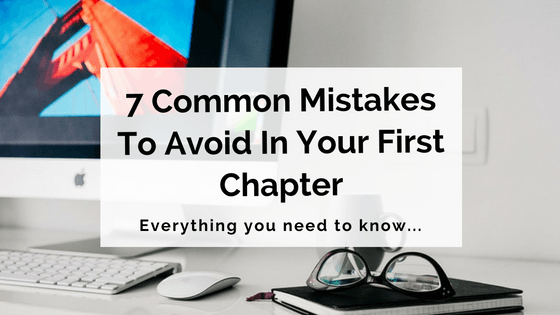Recently, we delved into what makes a great opener for a novel, covering the key elements to include in your first chapter. But just as there are important elements you should aim to include, there are also elements you should strive to avoid.
As we discussed previously, your first chapter has the power to make or break your novel in the eyes of readers, agents and editors alike. Clichés, weak writing, gluts of information, misplaced scenes – all these things have the potential to drive away your audience.

For most authors, it’s fairly easy to fall into the trap of any of the following undesirable elements. Mistakes are completely understandable, especially when you’re only on your first draft. But if you keep the following tips in mind while you write, you may be able to avoid them.
Alternatively, if you come back and edit later referring to these guidelines, you can ensure your first chapter is as sharp and effective as possible.
Let’s dive right in and take a look at seven elements to avoid in your first chapter.
1. An overly slow opening
Take a look at where you’ve decided to begin your novel. At what point in the story do your first chapter’s events take place?
Is your opening chapter set before the ‘inciting incident’? Does it take you a few pages, or even a few chapters, to get to what’s essentially the ‘real’ story? Do you start things off slow to ease the reader into the story?
If you answered ‘yes’ to any of these questions, it’s likely you have a problem with a too-slow opening chapter. You may be trying to introduce your audience too gradually to the characters, the world and the plot of your novel. This could cause readers to become bored or restless, or wonder when things are going to start happening.

Remember that you must give your audience a reason to keep reading! It’s the job of your first chapter to represent the rest of the story and convince your readers that it’s worth continuing.
For this reason, you shouldn’t wait to jump into the heart of the story. You don’t necessarily need to begin at the very beginning! You want to grab your readers right away, whether that be with action, an intriguing or mysterious situation, conflict between characters, etc.
There’s no use starting off slow, describing your protagonist getting up and going through their daily routine before anything out of the ordinary happens. Instead, get right to the point and convince your readers that they need to know what happens next.
2. Generic or clichéd beginnings
How many times have you read a book that opens with something you’ve read a thousand times before? Beginning your novel with a scenario that’s common, generic or clichéd is a surefire way to turn readers away.
Here are just a few of the most common clichés we’d recommend avoiding in your first chapter:
- Character waking up, especially to the sound of an alarm clock
- Dream sequence
- Character ruminating about their problems
- Description of the weather
- Character looking at themselves in a mirror and describing what they see
- Third-person description of a character, especially when focusing on their appearance
- First-person narration of character introducing themselves to the reader
- Premonition or overt foreshadowing (e.g. ‘John didn’t know that today would be the day he died.’)

If any of these scenarios are present in your first chapter, it might be time to rethink things. However, there are many more potential clichés to which you can fall prey, and you may not even realise your opening chapter is clichéd until you come back to edit it later. For this reason, it’s also good to get a few other people to read over your book (usually through a beta reader process).
They’ll be viewing it with fresh eyes and from the perspective of a reader, rather than the author of the work. This allows them to identify clichéd elements more easily and provide you with valuable feedback on your first chapter.
You can find out more about the beta reader process in our huge free crash course, How To Edit Your Novel.
3. Overwritten prose
With all the pressure to write an incredible first chapter, writers can often fall into the trap of trying too hard to impress their audience. Yes, you want to grab your reader and entice them to continue with the story. But when you overthink or overwrite while trying to do this, your opener can often end up having the opposite effect.
In our previous article, we spoke about establishing a strong authorial voice. While your voice and your unique writing style need to come across strongly in your first chapter, you can’t force either. And the more you try to do so, the more contrived, unnatural and overwritten your prose is likely to sound.
Flowery, purple prose; long words or complex sentences; attempts at achieving a highly ‘literary’ tone or style – all of these things can scream ‘overwritten’ to your audience. If a reader has to work too hard to understand or enjoy your first chapter, they’re much less likely to persevere with the rest of the story.

So how can you make sure you don’t come across like you’re trying too hard in your opener?
Firstly, when writing the first draft of your first chapter, try not to think too much about it. We know, we know – much easier said than done. It’s hard to forget the pressure behind a first chapter, but it’s what you need to do to achieve a truly natural tone.
It helps to remember that you can always come back and edit your work, or even rewrite it entirely if necessary. As we’ve said before, many authors actually choose to come back and rewrite their first chapter last, after they’ve finished the rest of the story. Keep this in mind during your first draft and simply let the words flow free.
4. Too much descriptive detail
As we’ve said many times before, conflict is the heart of all great fiction. And just as your novel as a whole should be replete with conflict, so your first chapter should begin the story with the presence of conflict.
However, a common mistake made by many writers is focusing on description and detail instead of actual plot in their first chapter. Whether it’s in-depth descriptions of characters’ appearances, or world-building in the form of detailed passages describing the setting, this kind of writing does not really belong in your first chapter.

The last thing you want is to leave your readers feeling bogged down in detail, struggling to keep reading. Don’t be fooled into thinking you need to ease them into the story by setting the scene in minute detail. It’s best to weave description and world-building details into the novel as a whole, rather than trying to pack them all into the first chapter.
With the purpose of your first chapter – drawing in the reader – in mind, focus on conflict. Allow your description to serve that conflict rather than including it merely for its own sake.
5. Backstory or info-dumping
This is a common misstep in many novels: first chapters as a vessel for backstory or info-dumping.
Backstory is necessary in many stories, especially in genres such as speculative fiction – but large amounts of it have no place in your opening chapter. Readers want to be immersed immediately in a story, not a backstory. Past details can come later; your first chapter is all about the hook, the moment, the here and now.
As literary agent Adam Chromy points out, ‘Many writers express the character’s backstory before they get to the plot. Good writers will go back and cut that stuff out… The character’s backstory stays with them – it’s in their DNA.’
Similarly, there should be no overwhelming info-dumps in your opening chapter (or anywhere in your novel, really – but that’s another matter!). An info-dump is a particular danger in genre fiction, where the world or plot often needs a little more explanation than general fiction.

Don’t worry that your readers won’t understand the plot without backstory or expositional information. Give them a little credit; they don’t need – or want – you to hold their hand throughout the whole thing. Readers will appreciate the opportunity to discover and understand the story themselves, through your own thoughtful, well-planned storytelling.
Often, once a writer finishes their first draft and comes back to edit, they’ll discover exposition or backstory in the first chapter, simply because they weren’t sure where to start the story. After all, your first draft is really just you getting to know your own story. Coming back to Chapter One after you’ve fleshed out the entire story will help you see what needs to be edited or cut completely.
We think author Chuck Wendig sums it up best:
The first chapter is not the place to tell us everything… Exposition kills drama. Backstory is boring. Give us a reason to care about that stuff before you start droning on and on about it.”
6. False beginnings/bait-and-switches
Be wary of a first chapter that reads like a false beginning, or a bait-and-switch situation.
For example, if you spend Chapter One exploring a particular character and striving to make your reader care about them, only to kill them off before Chapter Two – beware.
Your readers are likely to feel cheated. They’ll get a similar feeling if you begin with an engaging sequence that soon turns out to be a dream or illusion. In fact, there are many ways to inadvertently alienate your readers through a first chapter misunderstanding.

You must keep your intended audience in mind when writing your first chapter. If your opener is nothing like the rest of your story, you risk turning off the right readers and attracting the wrong ones. As author Anne R. Allen points out:
You don’t want to start out a romantic comedy with a gruesome murder scene, or open a thriller with light, flirtatious banter. You want to immerse your reader in the book’s world from the opening paragraph.”
To remedy this, ensure that you have a clear focus for your story as a whole. It must blend seamlessly together as a narrative, with the overall tone, genre and style established clearly in the first chapter.
7. An unnecessary prologue
The prologue is a highly divisive element of modern literature. Some call for a blanket ban on the device, claiming it’s never a necessary inclusion. Others believe the prologue still has merit, when used correctly and effectively.
There are definitely arguments to be made for both sides of this debate. However, we’re not here to solve it! We’re simply advising against the use of an unnecessary prologue – one that hasn’t been thought through, or doesn’t really have a place at the beginning of your story.
While a prologue technically doesn’t count as ‘Chapter One’, it’s still the first thing people read when they open your book. Therefore, it needs to follow most of the same guidelines as a regular first chapter. In fact, it should include even more enticing elements to justify it being included before the standard first chapter.

If you’re not careful, your prologue may fall prey to one of the undesirable elements we’ve mentioned above. For example, readers could feel you’re pulling a bait-and-switch with them by beginning with a prologue that seemingly has little to do with the story that begins in Chapter One.
Similarly, your prologue may tend towards being a mere vessel for backstory or information you wish to convey to the reader before the ‘real’ story begins.
To avoid any of these situations, you must have a really good reason for including a prologue. Many readers will simply skip a prologue if it doesn’t immediately capture their attention, so you must be sure you really need it! Here are a few reasons you might need to include a prologue:
- To include vital information that does not fit anywhere else in the story. For example, your prologue may detail something significant that happened long in the past, allowing you to time-skip to the present story once you reach Chapter One.
- To present a different point of view than the rest of the story is written in. For example, an omniscient narrator when the rest of the novel is in close third-person perspective, or a POV character who does not appear again in the story (see George R. R. Martin’s prologue for A Game of Thrones for a great example of the latter). Remember that essential information must be divulged in this scenario.
- To grab readers with a strong hook that doesn’t necessarily fit in Chapter One. (Even in this case, remember that Chapter One is not exempt from having a hook of its own!)
There are a couple of handy tests you can do to ensure your prologue is really necessary. First, try omitting it altogether and see if the rest of the story is negatively affected. If the story works just fine without it, and there’s nothing missing, you don’t really need the prologue.
Next, recast it as ‘Chapter One’ instead of ‘Prologue’ and see if this makes any difference to the flow of the story. If it reads just fine with the prologue as the first chapter instead, it’s best to leave it this way.
***
Have you identified any of these elements in your first chapter draft? If so, how will you fix them? And what are your personal pet peeves when it comes to opening chapters? Let us know in the comments below!
8 responses to “7 Common Mistakes To Avoid In Your First Chapter”
I include weather r in my opening scene, As it helps set the mood and plays a part int he action.
Within the first two pages, I have a woman getting shot, The weather is also unusual for the location, LA, cold and rainy, and generally wet for at least a week.
Great post! I’m having dilemma with my upcoming NaNoWriMo project’s opening where my narrative character thinks of the place he is visiting and the weather (thus the weather descriptions) and how much it differs from the place he hails from and this kind of indicates the necessity that prompted him to leave his homeland and come to stay in a place where the weather immediately creates a bad first impression, kind of like the reaction Bella Swan had after arriving in Forks. I hope that doesn’t make it clichéd.
Great bit of advice. I wrote a perfect response but forgot to click the box saying I’m not a robot. Poof! Gone into cyberspace with all the space monkeys and magic fairies. So, freestyle without editing follows:
While reading your advice, I recognized problems I had with my earlier writings, a time when I did not know how to write well, even though I thought I had a best seller in my hands.
Listening and learning from great advice helps us write our initial draft with fewer problems and less rewrites in the editing process. The best advice I received was from an email response from David Morrell: “If it is only a paragraph or two, it is not worth it. Leave it out.” Short, sweet, and to chase. Reluctantly, I cut out the paragraphs in question (trusting my undo button) and read it. I did not undo the cut. He was right.
One thing I never liked when reading was to get the highest point first, or the resolve of the conflict. It all seems to go down hill from there for me. This tends to be in writing as well because I write without outlining. I wrote an outline once and never wrote the book. I already knew the outcome. Writing is a mystery to me.
Thank you for your great article here…or should I call it a blog…or post. Regardless, thank you.
Hi Lucinda,
Don’t you hate when that happens?! Thanks for taking the time to rewrite your comment after losing it!
Totally agree with everything you’ve said here. Interesting to hear that you write without outlining – sounds like an exciting way to tackle a project, and I’m sure it results in many surprise twists and turns for both yourself and the reader.
Glad to hear you enjoyed the article, and all the best with your writing in future!
-Claire
I’m convinced I should keep the prologue in my memoir, as it draws the reader immediately into an action scene when I crossed the Pacific Ocean with my partner. It shows parts of life on a small sailboat and it foreshadows how my relationship will be affected. It also shines light on my antagonist (my partner) and his behaviors. Yet, this action really takes place about halfway into the book, as I want my first chapter to start when he and I met in a less than ordinary situation. So, yes, I could cut this prologue and the story still stands. No, it could not be the first chapter. Yet, I’m reluctant to get rid of these 800 or so words, as they truly set the scene of what is to come, once the memoir gets “up to speed”.
Hi Liesbet,
It sounds like the prologue is a good opener to your memoir, setting the scene and giving a taste of what’s to come as the story of your life progresses. If you feel it works and serves the book well, by all means keep it in! At the end of the day it’s your story, and you need to present it in a way that feels right to you.
Thanks! This is really helpful!
Though for my prologue for one of my books is not at first vital information, it really pays off with the second read through. In my series, I’m aiming for my books to be interpreted differently the second time it is read. The prologue is especially important if a reader chooses to do a second read through and finally say, “Oh man, that makes sense!”
The first read through, it shows how terrible and heartless of a “villain” a certain character is, while the second read through will show how hard he and another character got it, and how much a reader can sympathize with him, and why he was never truly the “bad guy”.
Though someone who does not understand the context of the prologue quite yet (publisher, editor, reader etc.) might think it is extraneous. Would it be advisable to actually throw this in my final edit of my book, or should I leave it out for sake of misinterpretation, or should I do a flashback in the last book that refers to this moment to bind the first and third book together?
I’m still sort of a new writer since I’ve never published anything just yet, but I just don’t want to look back on my first book ever and think “Oh man, I was a terrible writer back then,”
Any advice for this? Sorry the question is extremely long…
Hi G.P.,
Without having read the prologue in question it’s hard for me to give a direct answer, so what I would recommend is testing the book with beta readers (we have a post about working with beta readers that you might like to read here). See how the prologue is received by your readers and ask them specific questions about how they responded to it on first read and then again having understood the context of the ‘villain’ character. This will be a good way to gauge how readers in general might respond to the prologue, and whether it’s an effective addition or might be better left out.
Hope this helps!